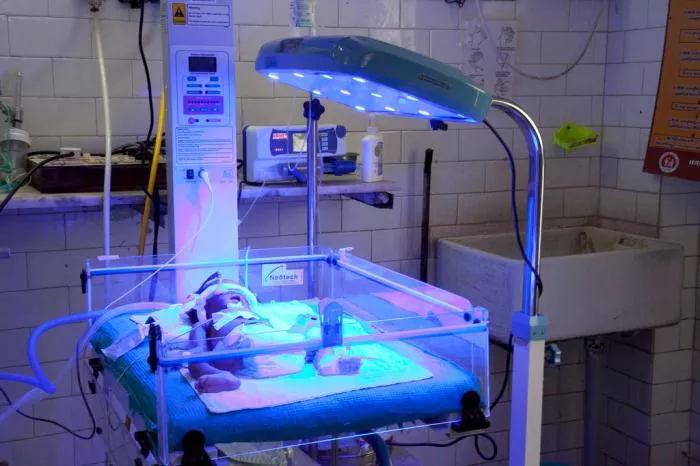Phototherapy is a common treatment used for newborns, particularly for conditions that require the reduction of certain substances in their blood. This article will explore what phototherapy is, its uses, and how it benefits newborns.
Understanding Phototherapy
Phototherapy is a medical treatment that uses light to treat specific conditions in newborns. The primary goal of phototherapy is to help the body process and eliminate excess substances that can be harmful if left untreated. This treatment is commonly used in hospitals and is an effective way to address several newborn health issues.
The treatment involves exposing the baby’s skin to a special type of light. This light helps break down certain substances in the blood, making them easier for the baby’s liver to process and remove from the body. Phototherapy is a non-invasive procedure and is typically well-tolerated by newborns.
See also: Why Is Phototherapy Used for Jaundice?
Common Uses of Phototherapy
Treating Neonatal Jaundice
One of the most common uses of phototherapy is for treating neonatal jaundice. Jaundice occurs when there is an excess of bilirubin in the baby’s blood. Bilirubin is a yellow pigment that is produced when red blood cells break down. In newborns, the liver may not be fully developed, making it difficult to process and eliminate bilirubin efficiently.
Phototherapy helps to break down bilirubin into a form that can be more easily excreted from the body. The baby is placed under a special light, which helps to convert the bilirubin into a water-soluble form. This form can then be eliminated through urine and stool.
Treating Hyperbilirubinemia
Hyperbilirubinemia is a condition where there is an elevated level of bilirubin in the blood. It is often seen in newborns with jaundice. Phototherapy is used to lower bilirubin levels and prevent complications associated with high bilirubin levels, such as brain damage.
Phototherapy can be administered in different forms, including overhead lights, biliblankets (which are wrapped around the baby), or a combination of both. The choice of method depends on the severity of the hyperbilirubinemia and the specific needs of the baby.
Managing Other Conditions
In addition to jaundice and hyperbilirubinemia, phototherapy may be used for other conditions that require the breakdown of certain substances in the blood. For example, it can be used in the management of certain metabolic disorders or to address specific types of anemia.
The use of phototherapy for these conditions is less common but may be indicated based on the baby’s specific diagnosis and treatment needs. The underlying principle remains the same: using light to aid in the breakdown and elimination of harmful substances from the body.
How Phototherapy Works
The Phototherapy Process
During phototherapy, the baby is placed under a special light source. The light used in phototherapy is typically in the blue spectrum. This specific wavelength is effective in breaking down bilirubin in the skin. The baby may be placed under an overhead light or be wrapped in a biliblanket that emits the light.
The baby’s eyes are protected with eye shields to prevent any potential damage from the light. The baby’s temperature is carefully monitored to ensure that they remain comfortable and safe throughout the treatment.
Duration and Frequency of Treatment
The duration and frequency of phototherapy depend on the severity of the condition being treated. In cases of neonatal jaundice, treatment typically lasts for a few days, but this can vary. The baby’s bilirubin levels are monitored regularly to determine how long phototherapy is needed.
The treatment may need to be adjusted based on the baby’s response and any changes in their bilirubin levels. Healthcare providers will provide guidance on the appropriate duration and frequency of phototherapy for each individual case.
Potential Risks and Side Effects
Common Side Effects
Phototherapy is generally considered safe, but there can be some side effects. Common side effects include:
Mild skin rashes or dryness
Changes in stool color (due to increased bilirubin elimination)
Dehydration or changes in fluid balance
These side effects are usually temporary and resolve once the phototherapy treatment is completed.
Rare Complications
In rare cases, more serious complications can occur. These may include:
Eye irritation or damage if eye protection is not properly used
Overheating or underheating if the baby’s temperature is not monitored carefully
Dehydration or electrolyte imbalances
Healthcare providers will monitor the baby closely during phototherapy to minimize the risk of these complications and ensure that the treatment is effective and safe.
Conclusion
In summary, phototherapy is a valuable treatment used for newborns to manage conditions such as neonatal jaundice and hyperbilirubinemia. By using light to break down excess bilirubin and other substances, phototherapy helps to improve the baby’s condition and prevent complications.
Understanding how phototherapy works, its uses, and potential side effects can help parents and caregivers feel more informed and prepared. If your newborn requires phototherapy, rest assured that this treatment is a standard and effective approach to addressing specific health issues. Regular monitoring and professional care will ensure that the treatment is safe and beneficial for your baby’s health.


